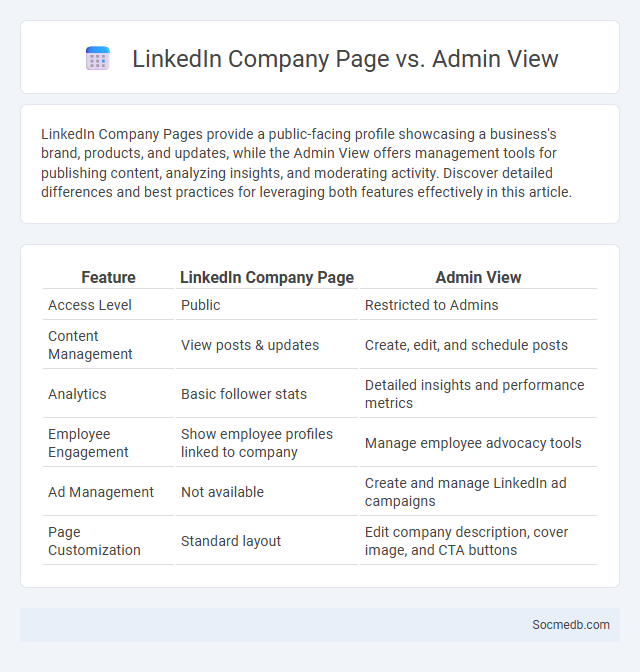
Photo illustration: LinkedIn Company Page vs Admin View
LinkedIn Company Pages provide a public-facing profile showcasing a business's brand, products, and updates, while the Admin View offers management tools for publishing content, analyzing insights, and moderating activity. Discover detailed differences and best practices for leveraging both features effectively in this article.
Table of Comparison
| Feature | LinkedIn Company Page | Admin View |
|---|---|---|
| Access Level | Public | Restricted to Admins |
| Content Management | View posts & updates | Create, edit, and schedule posts |
| Analytics | Basic follower stats | Detailed insights and performance metrics |
| Employee Engagement | Show employee profiles linked to company | Manage employee advocacy tools |
| Ad Management | Not available | Create and manage LinkedIn ad campaigns |
| Page Customization | Standard layout | Edit company description, cover image, and CTA buttons |
Introduction to LinkedIn Company Pages
LinkedIn Company Pages serve as a vital platform for businesses to establish their brand identity, showcase products or services, and engage with a professional audience. These pages offer features such as detailed company descriptions, job postings, employee connections, and analytics to track visitor engagement. Optimizing a LinkedIn Company Page enhances visibility, credibility, and networking opportunities within targeted industries.
What Is the LinkedIn Company Page?
The LinkedIn Company Page is a dedicated profile on LinkedIn designed for businesses to showcase their brand, share updates, and engage with their target audience. This platform enables your company to post job openings, highlight products or services, and build professional relationships with potential clients or employees. Utilizing a LinkedIn Company Page effectively can boost your brand visibility and establish industry authority.
Exploring the Admin View on LinkedIn
The Admin View on LinkedIn offers detailed insights into your company page's performance, including follower demographics, engagement metrics, and content reach, enabling you to tailor your social media strategy effectively. This feature allows you to monitor post analytics, manage page settings, and respond to comments, ensuring your brand voice remains consistent and engaging. Leveraging the Admin View empowers you to optimize your LinkedIn presence and connect more meaningfully with your audience.
Company Page vs Admin View: Key Differences
Company Page displays your brand's public profile, showcasing posts, updates, and customer interactions to maximize audience engagement. Admin View offers you exclusive tools for content management, analytics, and user permissions to efficiently oversee page operations. Understanding these differences empowers your team to optimize both public presentation and backend administration effectively.
Features Exclusive to LinkedIn Company Page
LinkedIn Company Pages offer features tailored for professional branding including detailed company descriptions, employee testimonials, and job postings that enhance recruitment efforts. Unique analytics tools track visitor demographics and engagement metrics, allowing precise targeting and optimization of content strategy. Integration with LinkedIn Ads provides advanced campaign management to reach specific professional audiences effectively.
Admin Tools and Permissions Explained
Admin tools in social media platforms provide essential features for managing user interactions, content moderation, and access control, enabling efficient community governance. Permissions settings allow administrators to assign specific roles such as moderators, editors, or contributors, each with tailored access levels to perform designated tasks securely. Leveraging these tools optimizes engagement, ensures compliance with platform policies, and maintains a safe, organized environment for users.
How Employees See the Company Page
Employees often view their company's social media page as a reflection of its culture, values, and reputation, influencing their sense of pride and engagement. Your company page can serve as a powerful tool to highlight employee achievements, promote internal initiatives, and foster transparency. Positive perceptions of the page contribute to higher employee advocacy and can enhance recruitment by showcasing an authentic workplace environment.
Best Practices for Managing LinkedIn Company Pages
Optimizing your LinkedIn Company Page involves regularly updating content with industry-relevant posts to engage your target audience effectively. Utilize LinkedIn analytics to track visitor demographics and adjust your strategy for maximum reach and lead generation. Consistent branding and clear calls-to-action help transform your LinkedIn presence into a powerful tool for business growth and professional networking.
Common Mistakes to Avoid: Admin vs Public View
Confusing admin view with public view on social media platforms leads to misjudging user experience and content visibility, often causing oversight in assessing what the audience truly sees. Admins must regularly use incognito mode or log out to verify posts, comments, and profile appearance from a public perspective, ensuring accurate moderation and engagement. Ignoring this practice results in undiscovered errors like hidden content, privacy settings mishaps, or broken links, compromising brand reputation and follower trust.
Optimizing Your LinkedIn Company Presence
Optimizing your LinkedIn company presence involves crafting a compelling and informative company page that highlights your brand's unique value proposition and industry expertise. Use targeted keywords in your company description to improve search visibility and regularly post relevant content to engage your audience and attract potential clients or talent. You should also leverage LinkedIn analytics to monitor performance metrics and adjust your strategy for maximum reach and impact.
 socmedb.com
socmedb.com